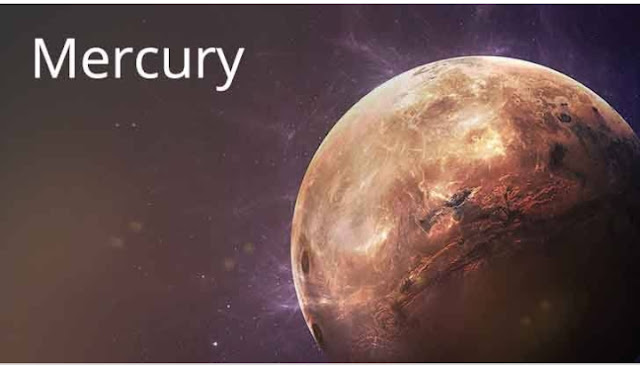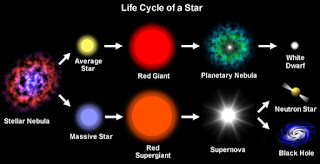PLANET MERCURY
Mercury is the smallest planet in the Solar System and the closest to the Sun. Its revolution around the Sun takes about 88 Earth days, which is the shortest of all the other planets. Planet Mercury is named after the Roman God Mercurius, God of Commerce, messenger of Gods, and mediator between Gods and mortals, corresponding to the Greek God Hermes.
Like Venus, Earth and Mars, Mercury is also a rocky planet means it has a solid surface that is covered with craters. This is the only planet in the Solar System which doesn't have any moon. Despite of the fact that it is closest to the Sun, it is not the hottest one, the hottest of all is Venus. It's diameter is about one-third of the Earth's, and its mass about 5% of the Earth's. The high density of Mercury comes from the fact that it has a large iron core, which occupies about 75% of the Planet's volume.
The precession of the orbit is not peculiar to Mercury, all the planetary orbits process. In fact Newton's theory predicts these effects, as being produced by the pool of the planets on one another. The question is whether Newton's predictions agree with the amount and orbit precesses; it is not enough to understand qualitatively what is the origin of an effect, such arguments must be backed by hard numbers to give them credence. The precession of the orbits of all planets except for Mercury's can, in fact, be understood using Newton's equations. But Mercury seemed to be an exception.
Physical Characteristics
Mercury is a Terrestrial Planet like Earth, and has a rocky body like that of the Earth. It is the smallest planet with an equatorial diameter of 4879.4 kilometres (3032 mi). Saturn's moons Ganymede and Titan are also larger that the size of Mercury.
Mercury appears to have a solid silicate crust and mantle overlying a solid, iron sulphide outer core layer, a deeper liquid core layer, and a solid inner core. The planet's Density is 5.427grams per cubic centimetre which is the the second highest in the Solar System after the Earth's which is 5.515 grams per cubic centimetre. Core of the planet Mercury's core is rich in iron content as compared to any other planet in the Solar System.
According to research, Mercury's core occupies approximately 42% of its solid matter while Earth's core occupies only 17%. According to some researches Mercury also has a liquid core. This core is occupied 500-700 km (310-430 mi) of mantle made of silicate. Based on the information given by the Mariner 10 Spacecraft Mercury's crust is estimate to be 35 km (22mi) thick.
Some details related to characteristics of the planet are as follows:
1. Surface temperature: –184°C (–300°F) to 465°C (869°F)
2. Distance from Sun: 58 million kilometers (36 million miles)
3. Diameter: 4879 km (3032 miles)
4. Gravity: 3.7 m/s², 38% of Earth's
5. Solar day: 58.6 Earth days
6. Solar year: 88 Earth days
7. Atmosphere: very thin made up of oxygen, sodium and helium.
8. Satellites: None
9. Surface Area: 7.48*10⁷ km²
10. Volume: 6.083*10¹⁰ km³
11. Mass: 3.3011*10²³ kg
12. Density: 5.427g/cm³
Magnetic Field
Despite of a longer axis rotation period of 58 day, Mercury has a notable and Global magnetic field. According to the traces taken by Mariner 10 Spacecraft it is 1.1% stronger than that of the Earth's magnetic field. Measurements from both the Mariner 10 and MESSENGER space probes have indicated that the strength and shape of the magnetic field are stable.
Mysterious Orbit of Mercury
A long-standing problem in the study of the Solar System was that the orbit of Mercury did not behave as required by Newton's equations.
To understand what the problem is, let me describe the way Mercury's orbit looks. As it orbits the Sun, this planet follows an ellipse...but only approximately: it is found that the point of closest approach of Mercury to the sun does not always occur at the same place but that it slowly moves around the sun. This rotation of the orbit is called a precession.
As seen from Earth the precision of the Mercury's orbit is measured to be 5600 seconds of arc per century (one second arc= 1/3600 degrees). Newton's equations, taking into account all the effects from the other planets (as well as a very slight deformation of the Sun due to its rotation) and the fact that the Earth is not an inertial frame of reference, predicts a precision of 5557 seconds of arc per centuri. There is a discrepancy of 43 seconds of arc per century.









Thank you so much for all the informations!!! 👍🏽💖💯
ReplyDeleteMind-blowing 🤯..!!